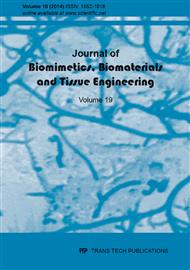[1]
N.K. Mekala, R.R. Baadhe and S. R, Parcha, Review on engineering biomaterials in tissue engineering application, Recent Research in Science and Technology 4.
Google Scholar
[12]
(2012) 5-11.
Google Scholar
[2]
S. -W. Yook, H. -E. Kim, B. -H. Yoon, Y. -M. Soon, Y. -H. Koh, Improvement of compressive strength of porous hydroxyapatite scaffolds by adding polystyrene to camphene-based slurries, Materials Letters 63 (2009) 955-958.
DOI: 10.1016/j.matlet.2009.01.080
Google Scholar
[3]
X. Liu, W. -H. Huang, H. -L. Fu, A. -H. Yao, D. Wang, H. Pan, W.W. William, Bioactive borosilicate glass scaffolds: Improvement on the strength of glass-based scaffolds for tissue engineering, Journal of Materials Science: Materials in Medicine 20 (2009).
DOI: 10.1007/s10856-008-3582-3
Google Scholar
[4]
S.S. Henriksen, M. Ding, M.V. Juhl, N. Theilgaard, S. Overgaard, Mechanical strength of ceramic scaffolds reinforced with biopolymers is comparable to that of human bone, Journal of Materials Science: Materials in Medicine 22.
DOI: 10.1007/s10856-011-4290-y
Google Scholar
[5]
(2011) 1111-1118.
Google Scholar
[5]
J.R. Jones, L.M. Ehrenfried, L.L. Hench, Optimising the Strength of Macroporous Bioactive Glass Scaffolds, Key Engineering Materials 254-256 (2004) 981-984.
DOI: 10.4028/www.scientific.net/kem.254-256.981
Google Scholar
[6]
F. Baino, E. Verné, C. Vitale-Brovarone, 3-D high-strength glass-ceramic scaffolds containing fluoroapatite for load-bearing bone portions replacement, Materials Science and Engineering 29.
DOI: 10.1016/j.msec.2009.04.002
Google Scholar
[6]
(2009) 2055-(2062).
Google Scholar
[7]
Y. Zhang, D. -S. Kong, Y. Yokogawa, X. Feng, Y. -Q. Tao, T. Qiu, Fabrication of porous hydroxyapatite ceramic scaffolds with high flexural strength through the double slip-casting method using fine powders, Journal of the American Ceramic Society 95.
DOI: 10.1111/j.1551-2916.2011.04859.x
Google Scholar
[1]
(2012) 147-152.
Google Scholar
[8]
M. Lipowiecki, D. Brabazon, Design of bone scaffolds structures for rapid prototyping with increased strength and osteoconductivity, Advanced Materials Research 83-86 (2010) 914-922.
DOI: 10.4028/www.scientific.net/amr.83-86.914
Google Scholar
[9]
Y. -M. Soon, K. -H. Shin, Y. -H. Koh, J. -H. Lee, H. -E. Kim, Compressive strength and processing of camphene-based freeze cast calcium phosphate scaffolds with aligned pores, Materials Letters 63.
DOI: 10.1016/j.matlet.2009.04.013
Google Scholar
[17]
(2009) 1548-1550.
Google Scholar
[10]
Q. Wu, X. -L. Zhang, B. Wu, W. Huang, Fabrication and characterization of porous HA/β-TCP scaffolds strengthened with micro-ribs structure, Materials Letters 92 (2013) 274-277.
DOI: 10.1016/j.matlet.2012.09.118
Google Scholar
[11]
X. Miao, M. Dawn, J.L. Tan, X. Yin, C. Ross, Mechanical and biological properties of hydroxyapatite/tricalcium phosphate scaffolds coated with poly(lactic-co-glycolic acid), Acta Biomaterialia 4 (2008) 638–645.
DOI: 10.1016/j.actbio.2007.10.006
Google Scholar
[12]
T. Kokubo, Ca, P-rich layer formed on high-strength bioactive glass-ceramic A-W, J Biomed Mater Res 24.
Google Scholar
[3]
(1990) 331-343.
Google Scholar
[13]
X. Miao, L.P. Tan, L.S. Tan, X. Huang, Porous calcium phosphate ceramics modified with PLGA-bioactive glass, Materials Science and Engineering: C 27 (2007) 274-279.
DOI: 10.1016/j.msec.2006.05.008
Google Scholar
[14]
M. Pradhan, P. Bhargava, Effect of sucrose on fabrication of ceramic foams from aqueous slurries, J Am Ceram Soc 88.
Google Scholar
[1]
(2005) 216–218.
Google Scholar
[15]
H. Schmidt, D. Koch, G. Grathwohl, Micro/macro-porous ceramics from preceramic precursors, J Am Ceram Soc 84 (2005) 2252–2255.
DOI: 10.1111/j.1151-2916.2001.tb00997.x
Google Scholar
[16]
P. Sepulveda, F.S. Ortega, M.D.M. Innocentini, V.C. Pandolfelli, Properties of highly porous hydroxyapatite obtained by the gelcasting of foams, J Am Ceram Soc 83 (2000) 3021–3024.
DOI: 10.1111/j.1151-2916.2000.tb01677.x
Google Scholar
[17]
I. Jun, J. Song, W. Choi, Y. Koh, H. Kim, Porous Hydroxyapatite Scaffolds Coated With Bioactive Apatite–Wollastonite Glass–Ceramics, J. Am. Ceram. Soc 90.
DOI: 10.1111/j.1551-2916.2007.01762.x
Google Scholar
[9]
(2007) 2703–27.
Google Scholar


